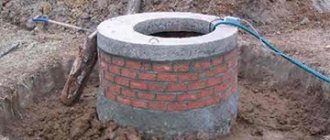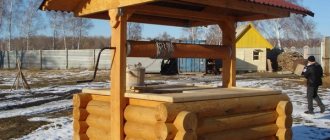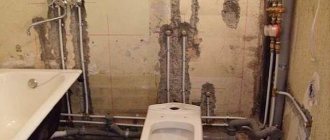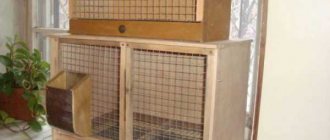Winter water supply from a well or borehole is also called all-season water supply - such water supply works both in winter and summer. Winter water supply is protected from frost and laid taking into account low temperatures. Thanks to this, it can be used in any weather.
Winter water supply is required for everyone who plans to permanently live in a private house or regularly visit in winter.
In this article we will tell you what rules you need to follow when installing a winter water supply with your own hands so that it lasts all year round, and what mistakes you should avoid.
Features of winter water supply
To install a winter water supply you need:
- The source of water is a well or borehole, where water is available all year round. Before purchasing a plot, be sure to check this point with sellers or neighbors.
- Drain (preservation) system. With its help, water is drained from the entire system during conservation. For example, if you are planning to leave home for a long time. If the trip is planned to be short - for example, for the New Year holidays - then more and more often the water supply is not preserved, but the temperature in the room is left above zero - +5-+10°C.
Why do you need to drain water from pipes?
We all know that water turns into ice at low temperatures. At the same time, the ice expands and begins to put pressure on the walls of the pipes from the inside. They become deformed and connections begin to leak. In addition, the pipes will have to be heated until the ice completely melts. That is, you won’t be able to use the running water for several hours (or even days), and this is inconvenient.
Laying depth of winter water supply pipeline
It depends on the region. For example, in St. Petersburg and Moscow, the calculated depth is 1.2-1.4 meters, the pipe is laid 30 cm lower. However, in reality, the soil freezes so deeply only in harsh conditions: there is sand on the site, the groundwater is high, there is no snow or it is being cleared. Often the soil freezes deeply under a house if it stands on stilts or a columnar foundation.
The actual freezing depth in these regions rarely exceeds 60 cm in depth. But we still lay the pipe at a depth of 1.5 meters, and we control this moment using the installer’s photo report.
If you do not know the standard freezing depth of the soil, it can be calculated using the formula. You will find it in document SP 22.13330.2011:
5.5.3 The standard depth of seasonal soil freezing dfn, m, in the absence of long-term observation data, should be determined on the basis of thermal engineering calculations. For areas where the freezing depth does not exceed 2.5 m, its standard value can be determined by the formula:
where Mt is a dimensionless coefficient, numerically equal to the sum of the absolute values of average monthly negative temperatures for the winter in a given area, taken according to SNiP 23-01, and in the absence of data for a specific point or construction area - according to the results of observations of a hydrometeorological station located in similar conditions with the construction area; d0 is the value taken equal to 0.23 m for loams and clays; sandy loam, fine and dusty sands - 0.28 m; gravelly, large and medium-sized sands - 0.30 m; coarse soils - 0.34 m. The d0 value for soils of heterogeneous composition is determined as the weighted average within the freezing depth. The standard depth of soil freezing in areas where dfn > 2.5 m, as well as in mountainous areas (where the terrain, engineering-geological and climatic conditions change sharply), should be determined by thermal engineering calculations in accordance with the requirements of SP 25.13330.
Let's calculate the standard freezing depth in St. Petersburg. Open SP 131 13330.2012, table 5.1: Average monthly and annual air temperatures. It states that in St. Petersburg the average subzero temperature persists for four months: December (-3.9°C), January (-6.6°C), February (-6.3°C), March (-1. 5°C). We add these values and calculate the root. It turns out 4.3. Multiply this by d0.
For clays: 4.3x0.23 = 0.99.
For sandy loam and fine sand: 4.3x0.28 = 1.2.
0.99 and 1.2 are the standard freezing depth in meters.
For Moscow the numbers will be as follows:
For clays: 4.8x0.23 = 1.1.
For sandy loam and fine sand: 4.8x0.28 = 1.3.
Methods for installing winter water supply from a well or borehole
There are two ways to lay a pipeline for winter water supply:
- Laying the pipe below the freezing depth.
- Laying a pipe above the freezing depth with foam insulation and an internal heating cable.
We resort to the second method only in cases where it is impossible or too expensive to bury a water supply system to the required depth. For example, if there is quicksand, rocks or boulders. Most often - if there is granite rock on the site. This can be found in the Vyborg district of the Leningrad region and in Karelia.
In case of quicksand, the pipe can be buried below the freezing depth if you use a backhoe loader or mini-excavator. In this case, the equipment digs a trench, and the installer quickly lays the pipe before the trench is flooded. In this case, you cannot hesitate.
Important! When insulating a pipe, it is better to lay the heating cable inside. In this case, if something happens to the cable, it can be quickly replaced - there is no need to dig up the pipe. In winter conditions this may be difficult and you will have to wait until spring.
There are also various collective farm methods of supplying water to a private home, which can be used in winter. We will talk about them below.
How to install winter water supply below freezing depth
To lay a pipe below the freezing point of the soil, you need:
— Dig a trench from the well (well) to the house to the freezing depth plus an additional 30 cm. Trench width – 60 cm.
— Lay the HDPE pipe in a snake pattern. Most often, to supply water to a private home or cottage, we use 32 HDPE pipes marked with a blue stripe with a wall thickness of 2 mm.
— Fill the trench with soil, compacting it.
There is no need to insulate a pipe in the ground. We insulate only that section of the pipe that goes to the water entry point into the house and is located above the freezing point of the soil. We do the insulation with stenoflex (or an analogue made of foamed polyethylene) in two layers, and we also insert a 3-meter heating cable inside the pipe - no more is needed.
Please note that HDPE pipes do not require a sand cushion; they can be laid directly on the bottom of the trench.
The advantages of this method of laying “winter” pipes: it is relatively cheap and simple.
Minuses:
- A lot of excavation work will be required.
- If you make a mistake with the freezing depth, the water supply will freeze.
Install winter plumbing in a house with insulation
In this case, the pipe can be buried shallowly - at a distance of 40-60 cm from the zero mark. Extruded polystyrene foam is used as insulation.
Some engineers also recommend using polyethylene foam (“Stenoflex”) or mineral wool. However, we do not recommend following this advice. Such materials in the ground will quickly get wet and lose their insulation properties. In theory, you can look for flexible pipes with thermal insulation. They are mainly used for heating, but in theory they can also be used in water supply. However it is expensive.
The pipes used in this installation method are the same - 32 HDPE pipes with a wall thickness of 2 mm (SDR 17).
We fill the pipe in the insulation with soil. Some “experts” suggest filling it with crushed stone, but this is a bad option - the sharp edge of the crushed stone can crush the pipe. Especially if the soil is rocky. Yes, and crushed stone freezes well.
Are you able to foresee all this yourself?
In order to be able to install all the usual household appliances at your dacha and provide yourself with constant hot water, you need to make sure that water is supplied to the water collection points under a certain pressure. This task is also only possible for specialists with special knowledge and experience. Therefore, do not hesitate, contact professionals - and trouble-free summer and winter water supply to your dacha will be guaranteed!
There are two types of winter water supply for a dacha: for round-the-clock living in the house and for temporary stay. To an inexperienced layman it may seem that there is no difference at all, but experts will say: there are a number of significant differences between insulating pipelines and installing a conservation system.
How much does it cost to lay a winter water supply system per 1 linear meter?
installs water supply in:
— Moscow and Moscow region.
— St. Petersburg and Leningrad region.
The cost of laying a pipeline that can be used in winter depends on the region: in St. Petersburg the price of this service is 1000 rubles per linear meter, in Moscow - 1300 per linear meter. The difference in price is due to the difference in labor costs.
We dig water mains mostly by hand. This is cheaper for the client, and besides, the equipment does not damage the site. This is especially important if it is already landscaped.
How to install winter water supply from a well to a house with your own hands
In suburban areas, an autonomous winter water supply from a well is possible. In our articles on the website, we have repeatedly talked in detail about how to organize water supply from a well:
Water supply for a cottage from a well: how to do it yourself, diagrams, photos and detailed instructions - complete instructions on how to make a winter water supply for a private house from a well with your own hands.
Turnkey water supply from a well - about how we install water supply from a well.
Here we will focus only on the main points.
To organize winter water supply from a well you need:
Well.
It is important to know the minimum water level in the well. During a drought or winter, the water level in the well may drop to a minimum, and it will be impossible to use the water supply. If this happens to your neighbors, then it is better to drill a well.
Pump or pumping station.
A pumping station is installed if it is necessary to raise water from a depth of up to 8 meters.
Some well pumping stations, for example Grundfos MQ, are equipped with built-in automation: pressure switch, dry run and flow switch.
The station is installed in the house, in the bathroom or technical room.
Scheme of winter water supply from a well with a Grundfos MQ pumping station
The pump does not have the same restrictions as a pumping station. It is immersed directly into the well and connected to a waterproof outlet. In the diagram it looks like this:
Scheme of winter water supply from a well with a pump
Water supply pipe
– 32 HDPE pipe with a blue stripe. A blue stripe means that the pipe is intended for drinking and technical water supply. It is enough for almost any private home. However, for large cottages it is better to take a pipe with a diameter of 40 mm.
Hydraulic tank.
It is necessary so that there is always some supply of water in the house, and the pump does not turn on every time you need to wash your hands. Most pumping stations have a built-in hydraulic tank. But it can be very small. For example, the Grundfos MQ station has a hydraulic tank of only 800 ml. Ideally, a private home requires a hydraulic accumulator of 50 liters or more.
The hydraulic tank also protects against water hammer – a pressure surge in the system. It occurs when you have already turned off the taps, but the pump has not yet stopped working.
Inside the hydraulic tank body you can see a rubber “bulb” that expands and contracts when the pressure in the system changes
Filters.
We consider a coarse filter or oblique filter, as well as a fine filter, mandatory. The oblique filter protects the water supply from sand and other large particles. An important point when installing the filter: the sump where the debris settles should look down.
The fine filter is installed after the oblique filter. It protects the system from smaller debris. If your water exceeds some indicator (for example, iron), then additional filters can be installed on the system.
Automation
: pressure gauge, pressure switch, dry running relay. There is no need for a dry-running protection relay if water is supplied from the well using a submersible pump with a float. If there is no water, the float is lowered and the pump does not work. When the water arrives, the pump turns on.
If a station is installed, the dry-running relay will protect the system from idle operation. The pressure gauge measures the pressure in the system, the pressure switch controls the pump and maintains good pressure in the autonomous water supply system.
Check valve.
Prevents water from draining from the system back into the well when the pump is not running.
Heating cable.
A necessary item for plumbing a private home in winter. Thanks to it, the part of the pipe that goes above the freezing depth does not freeze. We use food-grade heating cable for installation inside a pipe, with a power of 10 or 13 W/m. It is easier to replace if necessary than the external one.
The food heating cable is inserted into the pipe using a gland - it is included in the kit.
Set of heating food cable for laying inside a pipe with a gland for water, 3 m
Drain valve.
With its help, it will be possible to drain all the water from the system for conservation or repair.
Automatic drain valve
There are automatic drain valves - Unipump, Gileks, Belamos and so on. They open automatically if the pressure in the system drops below 0.3-0.5 atm.
However, there are several problems with using an automatic drain valve:
— It cannot be used with a pumping station. When a surface pump is used, there is no pressure in the outer pipe, so the automatic drain valve will not work.
— Suspensions (coarse sand, pebbles) get into the drain valve, which is why it does not close completely.
— If water remains in the system in winter, the drain valve freezes.
— It is often installed too deep in the well. This results in a water column that is too high. It creates pressure and the valve does not work.
- If the water is high in the well, then it does not drain from the pipe, it remains at the same level. And here it doesn’t matter whether there is a drain valve or not.
You can also install a manual Gilex drain valve. It is installed on a HDPE pipe in the well closer to the bend, and a rope is tied to the tap. For the faucet to work, you need to pull the rope - it will open and the water will drain out. When there is pressure in the system, this may not be easy to do; you will have to apply force, so it is better to tie the rope tightly.
Mounted Gilex drain tap. The rope is threaded through a small hole on the right
How to drain water from a water heater
Having dealt with the pump, we move on to water heaters: storage heaters are usually installed in summer cottages, and on the eve of winter, the water from them must be completely drained. The heater is not intended for operation at subzero temperatures, and if even a little water remains in the device, it will not survive the winter.
Unfortunately, dacha owners often make mistakes when draining water in heaters and leave some water inside the device.
This is what happened to a user of our portal with the nickname megakino: he has a storage heater under the sink in his dacha. The instrument panel did not survive the first winter - it was squeezed out, and after the second, frozen water tore the entire hull.
Our user does not understand what happened: it seems that he drained the water according to all the rules and left the taps open for the winter.
Here's how FORUMHOUSE participants explained this mystery: the water from the heater was not completely drained; it was prevented by the check valve installed on the water supply. To accurately drain ALL the water from the water heater, you need to blow it out. The main thing here is not to confuse the cold and hot water inputs:
- open the cold water drain and supply hot air into the hot water pipe. The cold water inlet is located low, and when blowing into it, all the water can be displaced without any residue.
Jackson FORUMHOUSE User
If you do the opposite, you will get nothing but bubbles in the heater volume.
You can do it easier and install a water heater drain tap.
This is how the heater drain is equipped for our participant with the nickname Liftanuty.
How to install the drain valve correctly?
It is better to install the drain valve below freezing of the soil, that is, at a depth of 1.5-2 meters. If you install the valve in a well, then mount it closer to the adapter or head; if in a well, install it closer to the bend. The installation sequence is as follows:
- A hole is drilled in the HDPE pipe between the adapter and the pump
- The valve is fixed using two removable parts of the seat and mounting screws.
- The sealing ring is installed between the hole and the saddle.
You can install a homemade drain valve in the well:
— Install a tee or saddle with a tap in the well.
— Attach a 20 mm polypropylene pipe to the butterfly ball valve through a 32-20 mm adapter coupling.
— Use a grinder to make a slot in the coupling on the bottom side.
— Mount the pipe, which acts as a rod, in the well using plumbing clamps. To securely fix the pipe, two additional stop sleeves must be installed between the clamps. This is done so that the homemade rod does not “walk” vertically and fly off the tap.
However, such a winter valve has problems - the ball valves turn sour, and after some time it may not turn. We recommend periodically, for example, once a month, opening and closing the tap.
How to prepare an outdoor faucet for the winter
Summer residents bring the water supply to the street so that it is convenient in the summer to water their gardens, draw water into the pool and simply wash their hands. But the outdoor tap needs to be prepared for the winter.
Typically a simple ball valve is installed at the end of the pipe. But the mechanism is designed in such a way that, no matter what position the tap is in - closed or open - there is a cavity between the internal parts (ball sphere and body) that is constantly filled with water. If the liquid remains inside, then in the spring you will find either a dripping faucet, or even swollen, due to the internal expansion of moisture.
Therefore, the street tap must be emptied of water like the entire water supply system, and then left in a semi-closed state at about 45 degrees. In this position, the liquid will find a way out of the mechanism cavity and will not freeze inside.
Bypass drain system
The drainage system can be provided in the house using a bypass. The bypass is installed directly in front of the automation and hydraulic accumulator. It is designed in such a way that when the pump is turned off, water drains from the pipe to the check valve, but remains in the internal system. A tap is installed on the bypass line itself. When it is opened, water is drained from the internal system too.
A check valve is usually installed on a horizontal section of pipe. A tap is installed on the bypass line; when it is opened, water is also drained from the system.
How to bleed the water supply system at your dacha
To be completely sure that there is no water left anywhere, the dacha water supply system will have to be purged. Even a small amount of water in winter, turning into ice, can burst a pipe.
Jackson FORUMHOUSE Member
For the winter, I always blow all the pipes with air step by step, along different lines, because when simply draining, “bags” of water still remain.
Blowing is done with a valve to which a car compressor is connected. It is screwed to the ends of pipes or flexible hoses unscrewed from the water heater.
During blowing, the faucet taps should be closed and the drain taps should be open. After blowing, it is necessary to open all the taps, both drain and mixer taps, and leave them in this position until spring.
Here's why this is done: almost always, the shut-off valves in country water supply systems are ball valves, and in their design there is a cavity where water can remain. For the same reason, you need to unscrew the shower head, shake the water out of it and put it into storage.
To summarize, preparing a country water supply system for winter includes the following mandatory steps:
- draining water from the system through the drain valve;
- draining water from the pump;
- draining water from the water heater;
- draining water from the washing machine and dishwasher.
- gradual purging of all pipes.
Now all that remains is to remove water from the most dangerous elements of the drainage system: disassemble the siphons under the sinks, drain the water from the toilet tank and drain the water seal (for example, with a rubber bulb). In winter, instead of water, the water seal is filled with antifreeze - this way, unpleasant odors from the septic tank will not enter the house.
All that remains is to prepare the water supply and septic tank for wintering.
Winter water supply from a well
We wrote about what types of wells there are, about the types of casing pipes, and about choosing a pump here:
Water supply at the dacha from a well: diagrams, structure and instructions with photos on how to do it yourself.
If we are talking about a constant winter water supply from a well, then there are two ways to arrange it:
- Using a caisson.
— Using a downhole adapter.
Caisson
- This is a sealed container that is buried in the ground. It protects the head and automatic water supply from freezing in winter. Installing a caisson is more expensive than installing an adapter, but water can be distributed to several buildings at once. This is convenient if there is not only a house on the site, but also a bathhouse or a guest house. The caisson is made from different materials - concrete, brick, sheet material. We recommend buying caissons made of polypropylene. They are 100% sealed and reliable. They do not wrinkle in the ground and do not freeze in winter. They can be placed in any soil
Another important advantage of the caisson is that part of the automation can be installed in it.
How we install them is described here:
Turnkey construction of a well with a caisson.
Scheme of equipment for all-season water supply from a well with a caisson
Downhole adapter
– a device for removing a water pipe from the well casing. It is installed below the freezing depth, so it is excellent for arranging winter water supply from a well. However, it is used only when it is necessary to carry out water supply to only one building. It will also be difficult to use if the well casing is narrow - 90 mm. In this case, you will need to either use a caisson or expand the top of the pipe.
Construction of a well with a turnkey adapter.
Scheme of water supply equipment from a well with an adapter
Also, when installing a winter water supply from a well, you will need:
— HDPE pipe 32 mm.
— Hydraulic tank of 50 liters or more.
— Filters – coarse and fine.
— Automation – pressure switch, dry running relay, pressure gauge.
— Drain valve.
- Heating cable.
There are also various artisanal methods for constructing a well:
— Exiting the pipe directly from the head without a caisson or automation. This method may be suitable as a temporary solution for summer water supply, but it cannot be used permanently. Especially in winter.
— An insulated house with a pumping station directly above the well. The output is heated by a heating cable. A house is a more expensive option than a caisson, as more materials are used. There is another argument in favor of the caisson - it is buried in the ground. In winter it is warmer there than on the surface. In addition, caissons are made of polypropylene; they retain heat well. However, the pumping station cannot be installed even in a caisson - it operates at temperatures above +5-+10 °C.
From this photo you can get an idea of what it looks like. Although specifically in this case a pump is used, not a station
Installation stages
Work on installing a winter water supply system is carried out step by step:
- Land works. The bottom of the prepared channel must be compacted and a sand cushion 10-15 cm thick must be poured onto it. It is also compacted.
- Install pumping equipment. It is advisable to install the unit in an insulated caisson and on a special concreted platform. This will prevent it from vibrating.
- A hydraulic accumulator is connected to the pump. In this case, be sure to install a pressure switch.
- A hose and pipes are connected to the inlet and outlet pipes of the pump using fittings. The first is intended for drawing water from a well. The second is the immediate beginning of the pipeline.
- Stretch a line from the pump to the house or bathhouse. Pipe laying is done using a special soldering iron. To do this, one end of the pipe is inserted into a nozzle of the required diameter. The end of the coupling is put on the second part of the soldering iron. Hold for 3-5 seconds and join the two elements. It is important to insert the pipe into the fitting and turn them slightly. The molten polymer binds well, forming a strong, airtight connection.
- The pipes are insulated with the selected material. It is worth ensuring that the insulation is installed without gaps or cold bridges. Otherwise, they will cause condensation to appear, which will cause the system to freeze. At the time of laying the insulation, it is important to take care of its high-quality waterproofing or select a material that reacts inertly to water.
If mineral wool or polystyrene is used for insulation, it is advisable to cover them on top with a special coating of cement and broken glass. Otherwise, rodents may chew through the material in winter in search of warmth.
The last stage of installing a water supply system is backfilling it. The soil is laid loosely, without strong compaction. It is better to add more soil later when it settles than to compact the soil and risk breaking the entire system.
Insulation of equipment for winter water supply
In order for the water supply of a private house to work in winter, it is necessary to keep not only the pipe warm, but also the rest of the equipment: a hydraulic accumulator, a pumping station, automation, filters. If all this is located in the house, in the bathroom, then there is no problem. But sometimes equipment for autonomous water supply is located in an unheated technical room or in a caisson. For normal operation, the temperature in them must be above +5°C. Additionally, the hydraulic accumulator and the station can be insulated with sheets of foam plastic, penoplex, roll insulation with a foil layer, mineral or basalt wool.
The water in the well is freezing, what to do?
Water in a well freezes under the following conditions:
- If the water level in the well is high - above 2 meters from ground level.
— The upper rings of the well are not insulated.
In order for the water supply from a well to work in the country in winter, the well needs to be well insulated. To do this, the upper rings are wrapped in polystyrene foam, gluing it to the well with a special compound. The depth of insulation is equal to the maximum freezing depth in the region. If your well is already dug in and is freezing, then to install polystyrene foam you will need to first excavate the well. You can also insulate the soil around the well.
Well insulation. We also recommend insulating the soil around the well
Also, to insulate the well, you will need a head in the form of a house.
Well house with gate
Most often it is made of wood. You can do it yourself or order from a company. Such a house protects the well not only from snow and cold, but also from debris.
Insulated house for a well. Additional insulation can be laid between the wooden base of the house and the well. Then the water in the well will definitely not freeze.
Pipeline insulation
The first option, as a rule, is used not only in dachas, but in ordinary country houses and cottages. Since the owner lives all year round, additional insulation of pipes inside the building is no longer necessary.
The installation of water supply in a summer cottage must comply with strict rules. The most important thing is that the pipes are buried in the ground below the soil freezing line. Insulation is poured over them. The layer must be at least 30 cm. In the European part of Russia, the depth should preferably be at least a meter; to be completely sure, it is better to play it safe and make it 1.5 m. The material you can use is foam chips or expanded clay. If you take proper care of the insulation in advance, the water will have no chance to freeze. It is necessary to build some slope along the entire length towards the well. A passage corresponding to the dimensions of the selected pipe is cut out in the second ring of the well. Pipes can be metal, plastic, polyvinyl chloride, etc., the main thing is that the material does not crack under the influence of cold.
To get winter water supply to your dacha, you need to remember to build some slope that will be along the entire length towards the well. A passage corresponding to the dimensions of the selected pipe is cut out in the second ring of the well. Pipes can be metal, plastic, polyvinyl chloride, etc., the main thing is that they do not crack under the influence of cold.
Methods for defrosting water pipes
If the insulation is not enough, then either the entire system or its individual parts may freeze in extreme cold. The well has a weak point:
The pipes often freeze here
To avoid this, some users lower an incandescent light bulb into the well. It generates heat and prevents water from turning into ice. But this option is dubious and not safe. Moisture can get into the light bulb, it can burn out and even explode.
One of our clients once lowered an old Soviet boiler into a well. Someone was pouring hot water from a kettle onto the pipe. All this can work as a one-time solution if the pipe is already frozen. However, it is better to insulate the well and lay the pipes correctly to prevent such situations.
How to drain water from a washing machine and dishwasher
If a washing machine and dishwasher are left to spend the winter at the dacha, then they will also need to be dehydrated. There can be difficulties with dishwashers, as our users say, “they have real labyrinths for water inside.” Therefore, if the manufacturer’s instructions do not directly indicate that the device can be wintered in an unheated room, and the preparation steps for such wintering are not outlined, it is better not to take risks.
With washing machines everything is simpler. To drain the water from the washing machine, you need to:
- Disconnect the machine from the water supply and sewerage. Place the ends of both hoses into a low basin. Turn on the "drain" mode. Wait for the work to finish.
- Disconnect the machine from electricity. Place a flat container like a cat litter box and unscrew the drain pump cover.
- To be completely sure, you can turn the washing machine upside down and leave it to winter in this position.
But some models of washing machines have containers inside in which water may remain, and if not, access to them is possible only through partial disassembly.











